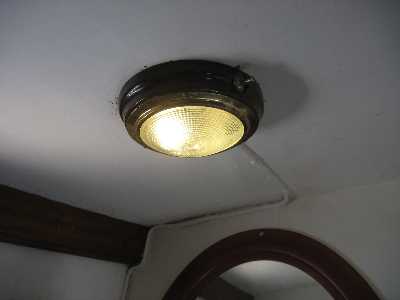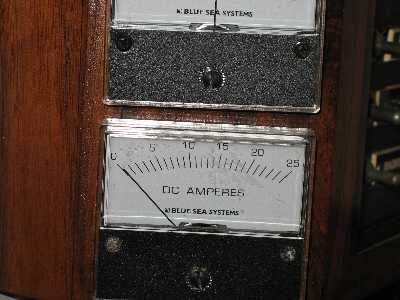Energy conservation
As long as I don't use too much electricity the solar panel keeps the battery nicely at a full charge. But some of the equipment aboard used a lot of energy. In particular, the cabin lights used halogen bulbs. These put out a nice, warm, bright light but they got too hot to touch. They drew 20 watts of power. During a cruise I had to impose a rule that they could only be used for a few minutes. Neadless to say it's a bit frustrating to have a dark cabin and try to cook food by flashlight. I replaced these with some "Sensibulbs" from Sailor Solutions. These are LED lights that put out a nice warm light but draw only a small fraction of an amp. Also they fit into the existing fixture.
 Fixture with a Sensibulb installed. |
 The current it uses. |
The running lights were next. I had to switch to LED lights. Also I wanted ones that were Coast Guard approved. This is not something for a homebrew solution. I read on the Woodenboat Forum about a skipper who was sailing at night. His stern light was inoperative so he relied on having the cabin light turned on. A police boat rammed him in the stern at high speed, killing one of the two policemen aboard. The unfortunate skipper was brought up on charges of manslaughter. Admiralty law is a real bear to be on the wrong side of. Thus the importance of following these regulations. I got a nice set of LED running lights at Pyacht.com. Once installed I found that the current consumption was cut considerably.
The following table gives the current consumption of various devices on the boat.
| Device | Current | Estimated Usage Per Week | Amp hours per Week | Estimated Use During a Cruise Per Day | Amp hours per day |
|---|---|---|---|---|---|
| Steaming Light | 1 A | 3 hours | 3 Ah | 1 hour | 1 Ah |
| Running Lights | 0.3 A | 3 hours | 0.9 Ah | 1 hour | 0.3 Ah |
| Engine Compartment Light | 0.3 A | 20 minutes | 0.1 Ah | 20 minutes | 0.1 Ah |
| Autohelm | 1.5 A when turning wheel, negligable otherwise. It turns the wheel probably 20% of the time. So 0.3 A | 1 hour | 0.3 Ah | 3 hours | 0.9 Ah |
| VHF | 0.2 A when not transmitting. | 1 hour | 0.2 Ah | 8 hours | 1.6 Ah |
| Depth Sonder | 0.2 A | 5 hours | 1 Ah | 8 hours | 1.67 Ah |
| Spreader Lights | 5 A | 20 minutes | 1.67 Ah | 20 minutes | 1.67 Ah |
| Masthead Light | 1 A | 5 hours | 5 Ah | 10 hours | 10 Ah |
| Stereo | 1 A | 12 hours | 12 Ah | 14 hours | 14 Ah |
| Total Usage | 24.17 Ah | 31.17 Ah | |||
| Solar charging | 1 A | 35 hours | 35 Ah | 1 hour | 1 Ah |
| Engine charging | 10 A | 45 minutes | 7.5 Ah | 4 hours | 40 Ah |
| Total Charging | 42.5 Ah | 41 Ah |
Note that the figures are approximate. The solar and engine charging are what these are capable of. The actual charging output tapers off as the battery reaches full charge. Thus the actual input does not exceed the actual usage. The solar panel provides a topping off charge that keeps the batteries fully charged. During normal usage as in a day sail on the weekend the solar panel does most of the charging. During a cruise the engine does most of the charging. Also a fully charged house battery should provide for an entire Great River Race. The house battery will then be able to start the engine for the return to dock.
Conclusion
There you have it. I now have an electrical system that works well and is reliable. It's also one that I can understand and fix myself. I have some 3 and 4 day cruises planned for the near future. This will tell for sure if this scheme works. Also I am looking at further improvements such as replacing the spreader lights and anchor light. I may look at replacing them with LED lights also.